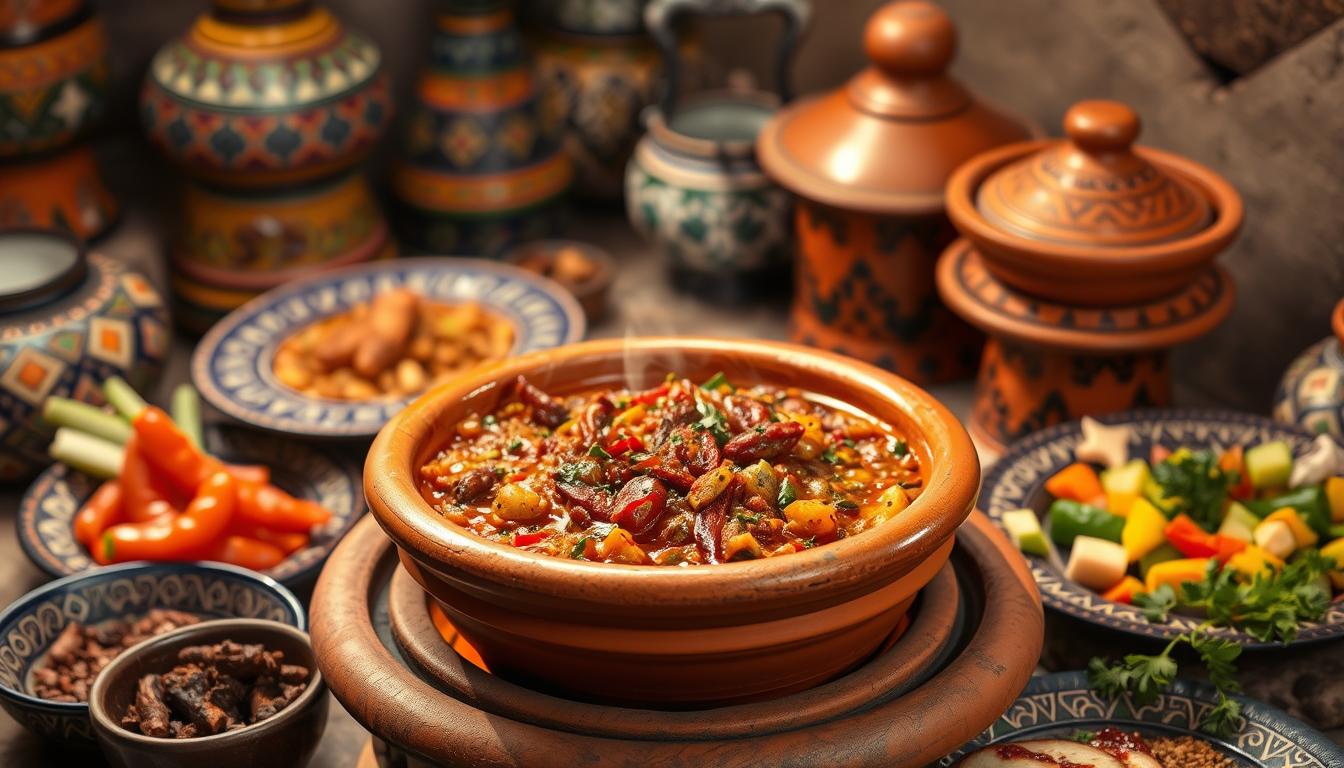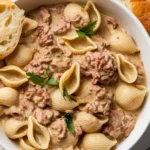Imagine stepping into a world where every bite tells a story. The aroma of Moroccan spices fills the air. Each tajine is a masterpiece of North African cuisine. Your culinary adventure starts with the rich, centuries-old art of tajine cooking.
Tajine Moroccan cuisine is more than just a meal. It’s a cultural celebration that brings people together. The slow-cooked delicacy represents generations of culinary wisdom.
It blends flavors that transport you to Marrakech’s vibrant markets. From tender chicken with figs and almonds to savory lamb with caramelized spices, each dish has its own story.
Whether you’re a food enthusiast or a curious traveler, tagine cooking offers an immersive experience. You’ll learn how traditional clay pots turn simple ingredients into complex, mouth-watering dishes. These dishes capture the essence of North African cuisine.
Key Takeaways
- Tajine represents a unique culinary tradition deeply rooted in Moroccan culture
- Moroccan spices play a critical role in creating distinctive flavor profiles
- Slow cooking is essential to developing rich, complex tastes
- Each tajine dish tells a story of regional ingredients and traditions
- The cooking method is as important as the ingredients themselves
Understanding the Rich Heritage of Moroccan Cuisine
Moroccan food is a mix of flavors from many cultures. It shows the strength, creativity, and innovation of Moroccan people over thousands of years.
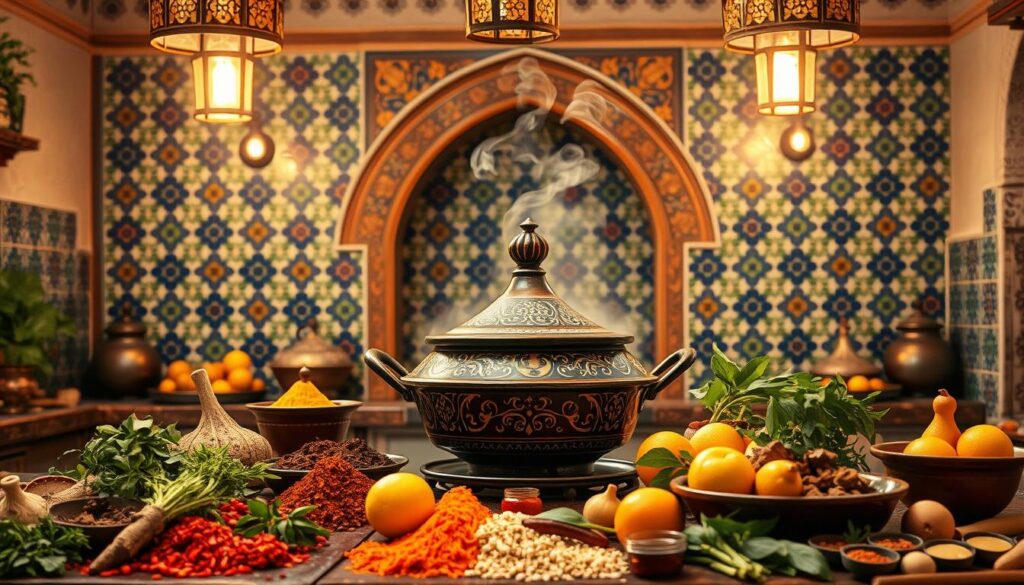
The roots of Moroccan dishes go back to the Berbers. They introduced cooking techniques that are key to Moroccan food. Berber ways of slow cooking and making meals together are important in Moroccan culture.
Origins of Traditional Moroccan Cooking
Moroccan food comes from many cultures. Important moments in its history include:
- Berber introduction of the tajine cooking vessel over 2000 years ago
- Arab influences bringing exotic spices from China, India, and Malaysia
- Moors expanding olive and citrus cultivation
- Ottoman contributions to grilling techniques
Cultural Influences on Moroccan Dishes
Moroccan food shows a mix of cultures. Each group added its own ingredients and ways of cooking. This mix changed the food scene.
| Cultural Group | Culinary Contribution |
|---|---|
| Berbers | Tajine cooking, communal meal traditions |
| Arabs | Spice introduction, sweet-sour flavor combinations |
| Moors | Olive cultivation, fruit tree gardening |
| Ottoman Turks | Grilling and barbecue techniques |
The Evolution of Tajine
The tajine is more than a cooking method. It shows the heart of Moroccan food. Starting as a simple Berber way to cook, it has become a sign of Moroccan culture and fine cooking.
“In every tajine, there is a story of generations, of landscapes, and of shared moments.” – Moroccan Culinary Proverb
The tajine has grown from a simple start to a famous dish worldwide. It shows how old cooking ways can cross time and cultures.
The Art of Tajine Moroccan Cuisine
Moroccan cooking is a true culinary masterpiece. It turns simple ingredients into amazing slow-cooked stews. The traditional tagines show the beauty of cooking techniques passed down through generations.
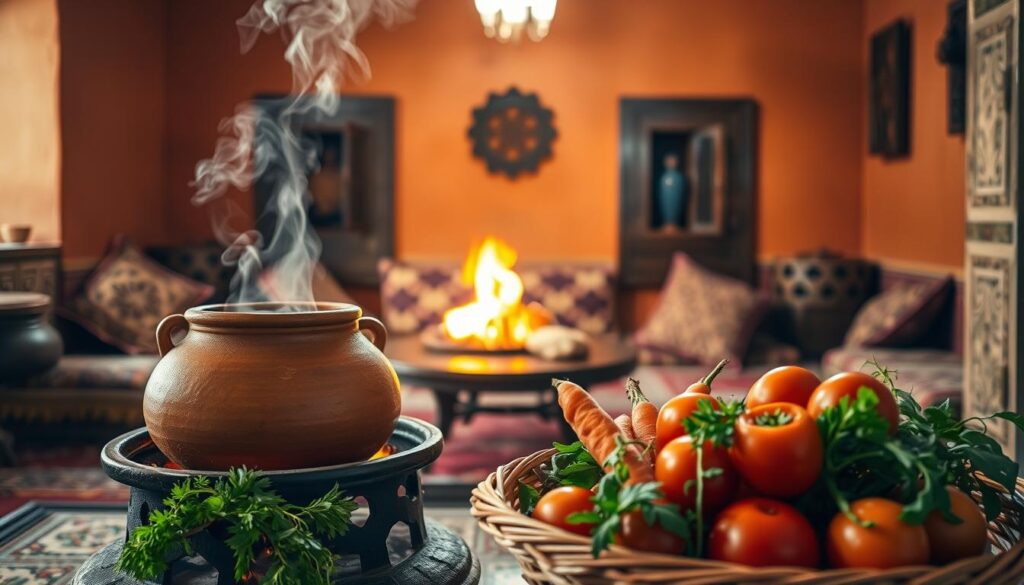
Clay pot cooking in Morocco is an art form. It needs patience, skill, and deep cultural understanding. The clay pot, called a tajine, cooks food slowly and intensely, bringing out amazing flavors.
“In every Moroccan kitchen, the tajine is not just a cooking vessel, but a storyteller of culinary traditions.”
Key Techniques in Tajine Preparation
- Carefully layer ingredients to ensure even cooking
- Use low heat to develop complex flavor profiles
- Allow ingredients to steam and blend naturally
- Select complementary spices for depth of taste
Moroccan cooks balance ingredients and spices with care. They know each layer adds to the dish’s harmony.
| Cooking Technique | Flavor Impact |
|---|---|
| Slow Steaming | Intensifies ingredient flavors |
| Layering | Ensures even heat distribution |
| Spice Blending | Creates complex taste profiles |
Exploring Moroccan cuisine shows a cooking style that makes ordinary ingredients into amazing meals. The tajine is more than food. It’s a symbol of hospitality, creativity, and culinary wisdom.
Essential Components of an Authentic Tajine
Moroccan cuisine is a rich mix of flavors, with the tajine pot at its core. Learning about the key parts turns cooking into a true culinary adventure.
The Traditional Clay Pot
The tajine pot is more than cookware; it’s a symbol of culture. Made from earthenware, it has a special cone-shaped lid. This design helps steam cook meat and infuse stews with deep flavors.
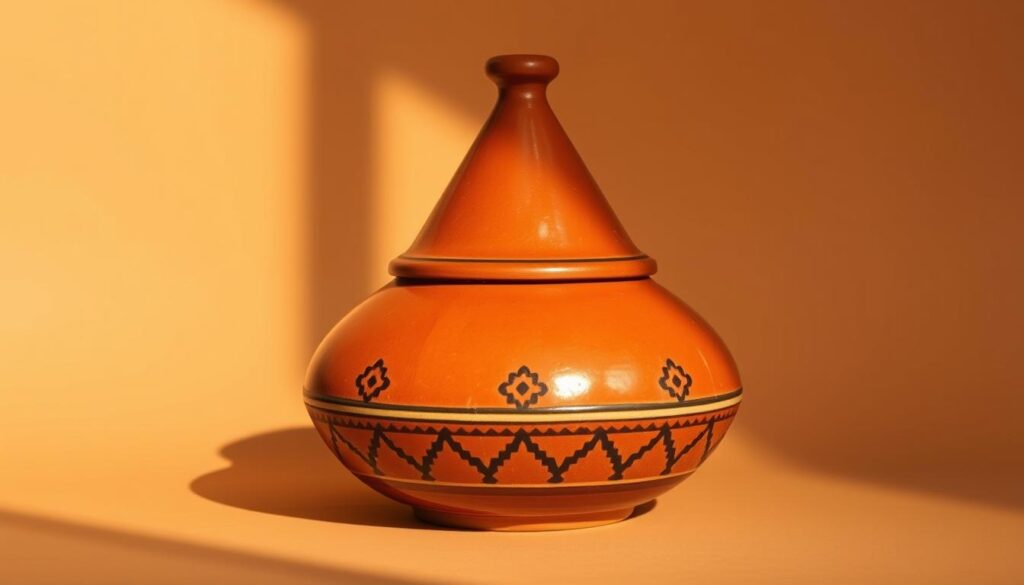
Key Ingredients and Spices from Morocco
Spices from Morocco are vital in making a tajine. You’ll learn to use saffron spice blends to make simple ingredients into amazing dishes.
- Saffron: The golden spice that adds rich color and depth
- Preserved lemon recipes: Providing tangy, intense flavor
- Cumin, turmeric, and ginger: Fundamental spice combinations
Regional Flavor Variations
Every Moroccan region adds its own twist to tajine cooking. This shows off local ingredients and traditions.
| Region | Characteristic Ingredient | Flavor Profile |
|---|---|---|
| Atlas Mountains | Lamb | Robust, hearty |
| Coastal Areas | Fresh seafood | Light, delicate |
| Desert Regions | Dried fruits | Sweet, complex |
“A true tajine is not just a meal, but a journey through Morocco’s diverse culinary landscape.” – Moroccan Cooking Proverb
Whether you’re new to cooking or have years of experience, learning about the tajine’s key parts will bring Marrakech’s vibrant streets to your kitchen.
Traditional Cooking Methods and Techniques
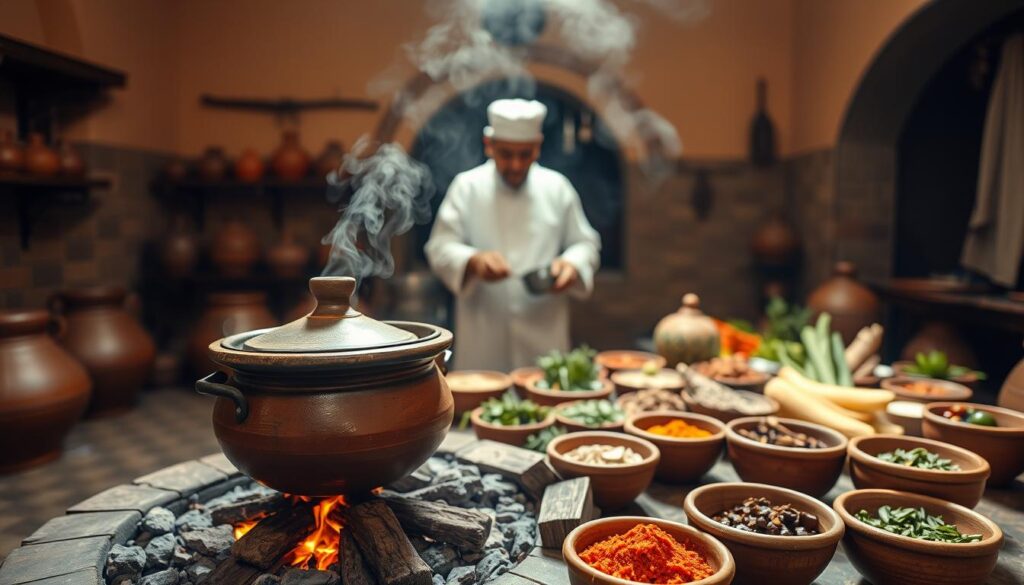
Moroccan tajine cooking is a true art form. It’s all about slow cooking. The earthenware pot is key, helping to create rich flavors.
Traditional Moroccan cooking turns simple ingredients into amazing dishes. The tajine pot, with its circular base and conical lid, is perfect for keeping moisture and flavors in.
“Slow cooking is not just a method, it’s a philosophy of transforming ingredients into culinary masterpieces.” – Moroccan Culinary Tradition
Key Slow Cooking Techniques
- Low heat simmering for 2-3 hours
- Layering ingredients strategically
- Minimal liquid usage
- Careful spice integration
The magic of tagine cooking is in its ability to make meat and vegetables tender. Berber cooking emphasizes patience and precision in making traditional dishes.
Spice and Flavor Development
| Spice | Flavor Profile | Typical Usage |
|---|---|---|
| Saffron | Subtle, Aromatic | 1-2 pinches |
| Cumin | Earthy, Warm | 1-2 teaspoons |
| Cinnamon | Sweet, Complex | 1/2-1 teaspoon |
Modern cooking tools like pressure cookers and slow cookers have made traditional tajine cooking easier. But, the essence of Moroccan cooking stays the same – it’s about changing ingredients with time, heat, and the right spices.
The Role of Spices in Moroccan Tajine
Moroccan spices are the heart of traditional tajine cooking. They turn simple ingredients into amazing dishes. The magic of Moroccan cuisine is in its ability to mix aromatic flavors. This creates a journey of taste through North African traditions.

Spices in Moroccan cooking are more than just ingredients. They tell stories. About 90% of traditional Moroccan meals use special spices. These spices add depth and character to every dish.
Essential Spice Blends
The secret to authentic Moroccan flavor is in its spice blends. Here are the main spices:
- Cumin: Earthy and warm
- Turmeric: Bright and slightly bitter
- Cinnamon: Sweet and aromatic
- Ginger: Zesty and sharp
- Paprika: Rich and slightly sweet
Ras el Hanout: The Crown Jewel of Spice Blends
Ras el hanout spice blend is the peak of Moroccan cooking. Literally meaning “top of the shop”, it has up to 100 different spices. Each merchant keeps their recipe secret, showing their cooking skill.
“Ras el hanout is not just a spice blend, it’s a cultural signature.” – Moroccan Culinary Expert
Preserved Lemons and Aromatic Flavors
Preserved lemons add a tangy taste to tajine dishes. When mixed with harissa paste, they create a unique Moroccan flavor. These ingredients make simple dishes into something special.
Moroccan spices are very versatile. With almost 75% of spices unique to the region, each tajine shares a story. It’s about tradition, family, and cultural heritage.
Popular Meat-Based Tajine Varieties
Moroccan cuisine is filled with delicious meat-based tajine dishes. Lamb tajine is a favorite, loved for its rich flavors. It’s a key part of Moroccan cooking.
The lamb tajine recipe is a masterpiece of Moroccan cooking. It uses tender meat and a mix of spices. This makes simple ingredients into amazing meals.
“In Morocco, a tajine is more than a meal—it’s a celebration of flavor and tradition.”
Each region in Morocco has its own twist on lamb recipes. For example, Marrakech’s tanjia is cooked slowly over ash. This makes the meat incredibly tender.
| Meat Type | Cooking Time | Typical Spices |
|---|---|---|
| Lamb | 2 hours | Cumin, Saffron, Cinnamon |
| Chicken | 1.5 hours | Ras el Hanout, Paprika |
| Beef | 2-2.5 hours | Turmeric, Black Pepper |
When making lamb tajine, slow cooking is key. It lets the spices deeply flavor the meat. This creates a true Moroccan taste experience.
Vegetarian and Fish Tajine Options
Exploring the world of vegetable tagines is a journey into Mediterranean diet flavors. Moroccan cuisine is full of plant-based and seafood dishes. These options make traditional cooking a tasty experience.
Vegetarian tagines are a colorful celebration of seasonal ingredients. They show how Moroccan cooking can be versatile and satisfying without meat.
Seasonal Vegetable Combinations
A typical vegetable tagine might include:
- 2 medium yellow onions
- 8-10 garlic cloves
- 2 large carrots
- 2 large russet potatoes
- 1 large sweet potato
The magic of these vegetable tagines is in their spice blends. A typical recipe might use:
- 1 tbsp Harissa spice
- 1 tsp ground coriander
- 1 tsp ground cinnamon
- ½ tsp ground turmeric
Seafood Tajine Specialties
Fish tagines add a new dimension to Moroccan couscous dishes. Traditional recipes use 900g of cod or firm white fish. The fish is marinated for 2-3 hours to boost flavor.
“In Morocco, seafood tagines are a testament to the rich coastal culinary traditions.”
When making seafood tagines, chefs add ingredients like:
- 2 bell peppers
- 1 large onion
- 2 large potatoes
- 4-5 fresh tomatoes
- Chermoula marinade
Whether you’re making a vegetable or seafood tagine, these dishes are a taste of Moroccan cuisine. Serve with fresh bread or couscous for a complete Mediterranean meal.
The Art of Layering Ingredients
Mastering the art of layering ingredients is key to making authentic Moroccan meals. This technique turns simple ingredients into aromatic stews. These stews are full of flavor and show the depth of Moroccan cuisine.
When making Moroccan tagine recipes, layering is more than just where you put things. It’s a strategy for perfect flavor and cooking. Chefs follow a specific order to make sure each ingredient is at its best.
“In Moroccan cooking, layering is an art form that speaks to centuries of culinary wisdom.”
- Start with hearty vegetables at the bottom
- Place meat in the middle layer
- Add delicate ingredients like herbs on top
- Use traditional cooking techniques to create depth
The weight and cooking time of ingredients matter a lot. Carrots and potatoes, which take longer to cook, go at the bottom. Meat goes next, soaking up flavors from the vegetables. Fresh herbs and preserved lemons go on top, adding their aromas during cooking.
Your tagine will have rich, complex flavors thanks to this careful layering. It turns simple ingredients into a masterpiece that shows the heart of Moroccan cooking.
Tajine Accompaniments and Side Dishes
In traditional Moroccan cooking, the tajine experience goes beyond the main dish. North African cooking highlights the art of accompaniments. These turn a simple meal into a feast of flavors and textures.
Bread is key in Moroccan hospitality. It’s not just a side item, but your main utensil for enjoying tajine. The local khobz is essential for scooping up rich, aromatic stews from the communal dish.
Traditional Bread Varieties
- Round khobz – thick, hearty bread
- Flatbread – thin and crispy
- Msemen – layered, flaky bread
Complementary Salads and Sides
Moroccan salads are cooked, unlike Western salads. These vibrant sides often include:
- Moroccan green salad with preserved lemon
- Spiced carrot salad
- Taktouka (pepper and tomato salad)
While couscous is popular, it’s not traditionally with tajine. Harira soup, though, is a classic partner, loved during Ramadan.
“In Morocco, a meal is not just food, but a celebration of community and shared experiences.”
Recommended Side Dish Pairings
| Tajine Type | Recommended Side Dish |
|---|---|
| Chicken Tajine with Lemons | Taktouka Salad |
| Vegetable Tajine | Spiced Carrot Salad |
| Lamb Tajine | Moroccan Green Salad |
These accompaniments are not just extras. They’re key parts that complete the rich tapestry of Moroccan culinary tradition.
Selecting and Caring for Your Tajine Pot
Choosing the right tagine pot is key for authentic Moroccan cooking. Traditional earthenware pots are more than just cookware. They open the door to rich flavors of clay pot meals passed down through generations.
- Material quality of the earthenware pot
- Glaze finish and durability
- Size appropriate for your cooking needs
- Origin and craftsmanship
Caring for your tagine pot needs special techniques. Urban Moroccans and rural cooking traditions both stress gentle handling and proper maintenance.
“A well-maintained tajine pot can last generations, telling culinary stories with each meal prepared.”
Here are key care tips for your traditional tajines:
- Always use a heat diffuser when cooking on stovetops
- Maintain low to medium-low cooking temperatures
- Hand wash after each use
- Avoid harsh detergents
| Cooking Method | Recommended Temperature | Cooking Time |
|---|---|---|
| Oven | 325-350°F | 2-4 hours |
| Stovetop | Low heat | Varies by recipe |
Proper curing is vital for new Moroccan cooking earthenware. Soak your pot for 24 hours, then cure in an oven at 225°F for 2 hours. This prevents cracking and ensures longevity.
Remember, a well-loved tajine pot becomes more than kitchenware. It’s a cherished culinary companion that connects you to centuries of Moroccan cooking traditions.
Common Mistakes to Avoid When Cooking Tajine
Learning to cook traditional Moroccan dishes like tajine is an art. Many people struggle with it, which can ruin the dish’s true taste.
“The secret to perfect tajine lies not just in the ingredients, but in the technique.” – Moroccan Culinary Wisdom
There are a few big mistakes to watch out for when cooking tajine:
- Using too much heat, which can break clay pots and mess up the flavors
- Putting too much in the tajine, which stops steam from moving around
- Not layering ingredients right
- Not browning the meat first
Managing heat is key in Moroccan cooking. Clay pots are fragile and can crack if the temperature changes too fast.
| Cooking Mistake | Potential Impact | Recommended Solution |
|---|---|---|
| High Heat | Pot Cracking | Gradual Temperature Increase |
| Overcrowding | Uneven Cooking | Leave 25% Volume Free |
| Insufficient Browning | Reduced Flavor Depth | Pre-sear Meats |
Your cooking should take 1 to 5 hours. This lets the flavors mix and get richer. Most recipes use 5-7 spices for a balanced taste.
Avoiding these mistakes will make your tajine cooking much better. You’ll get closer to the real Moroccan taste.
Modern Adaptations of Traditional Recipes
The world of moroccan tagine recipes is always changing. It mixes old north african dishes with new cooking ideas. Chefs and home cooks add local ingredients and modern methods to keep the true taste of marrakesh alive.
Contemporary moroccan cuisine has seen some exciting changes:
- Pressure cooker and slow cooker variations
- Health-conscious recipe modifications
- Fusion interpretations with global ingredients
- Vegetarian and plant-based alternatives
The tajine’s flexibility lets chefs get creative. They try new proteins and spice mixes, staying true to old cooking ways.
“Culinary innovation is about honoring tradition while embracing change.” – Moroccan Chef Perspective
| Traditional Element | Modern Adaptation |
|---|---|
| Lamb Tajine | Plant-based protein substitutes |
| Clay Pot Cooking | Electric slow cookers |
| Classic Spice Blend | Customized regional spice mixes |
Try these new takes on moroccan tajine by mixing old and new ingredients and methods. It’s a great way to keep the tradition alive while adding your own twist.
Conclusion
Moroccan tajine is more than just a dish; it’s a story of culture. It shows the deep flavors, techniques, and history of North African cuisine. It turns cooking into an art form.
Your exploration of Moroccan cooking is like entering a world of magic. Spices and herbs change everything. The Berber, Arab, and Moorish cultures all add their own touch to the tajine. Each dish is a story of cultural exchange and new ideas in cooking.
Moroccan hospitality is in every dish. It invites you to enjoy more than just food. It’s a journey of taste and culture. Whether you’re making a lamb tajine or trying new vegetable mixes, you’re part of a tradition that brings people together.
Remember, tajine is more than food; it’s a connection between cultures. It shows Morocco’s rich food history. Every clay pot, spice, and slow-cooked ingredient carries the warmth of Moroccan kitchens and the wisdom of generations.

